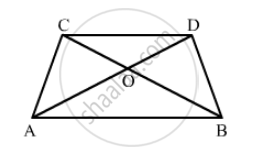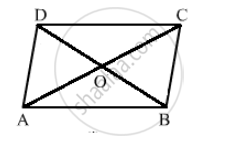Advertisements
Advertisements
प्रश्न
Given below is a parallelogram ABCD. Complete each statement along with the definition or property used.
(i) AD =
(ii) ∠DCB =
(iii) OC =
(iv) ∠DAB + ∠CDA =

उत्तर
The correct figure is

\[(i)\]\[AD = BC (\text{ opposite sides of a parallelogram are equal })\]
\[(ii)\] \[\angle DCB = \angle BAD \left( \text{ opposite angles are equal } \right)\]
\[(iii)\] \[OC = OA \left( \text{ diagonals of a prallelogram bisect each other } \right)\]
\[(iv)\] \[\angle DAB + \angle CDA = 180° \left( \text{ the sum of two adjacent angles of a parallelogram is } {180}^0 \right)\]
APPEARS IN
संबंधित प्रश्न
The following figure is parallelogram. Find the degree value of the unknown x, y, z.

ABCD is a parallelogram in which ∠A = 70°. Compute ∠B, ∠C and ∠D.
Two adjacent sides of a parallelogram are 4 cm and 3 cm respectively. Find its perimeter.
In the following Figure ABCD is a arallelogram, CE bisects ∠C and AF bisects ∠A. In each of the following, if the statement is true, give a reason for the same:

(i) ∠A = ∠C
(ii) \[\angle FAB = \frac{1}{2}\angle A\]
(iii) \[\angle DCE = \frac{1}{2}\angle C\]
(iv) \[\angle CEB = \angle FAB\]
(v) CE || AF
Which of the following statement is true for a rhombus?
Its diagonals are equal and perpendicular.
The diagonals of a quadrilateral are of lengths 6 cm and 8 cm. If the diagonals bisect each other at right angles, what is the length of each side of the quadrilateral?
The lengths of the diagonals of a Rhombus are 12 cm and 16 cm. Find the side of the rhombus
If the adjacent sides of a parallelogram are equal then parallelogram is a ______.
ABCD is a rhombus such that the perpendicular bisector of AB passes through D. Find the angles of the rhombus.
Hint: Join BD. Then ∆ABD is equilateral.
Construct a rhombus whose side is 5 cm and one angle is of 60°.
